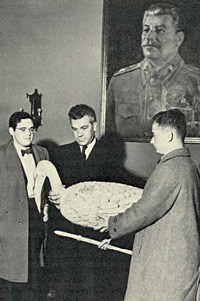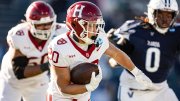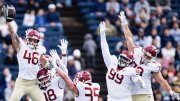Thayer. 2 a.m.Six freshmen, clad in muted grays, stocking-caps, and ski-masks, review, for the umpteenth time, their plot. Lock-pick kit? Check. Map? Check. Camera? Frantically, one of the conspirators searches his seemingly countless overcoat pockets. Finally, a Kodak disposable emerges. Check!
Once more: "We enter outside C___. Down the ladder. Last man down closes the grate. Clear the immediate vicinity as quickly as possible — we will trip the alarm. Head south — follow your map. Don't touch the pipes. Avoid puddles. Exit by M___, across the river. Clear out at first sign of cops. Nearest exit and scatter. Are all watches synchronized?"
Murmurs and nods. They are ready to go.
These are not the first Harvard students to crash the University's strictly verboten steam tunnels. But each surreptitious venture into the campus's balmy bowels brings with it new intrigue — and familiar risk. Any one of these six could still pull out, turn back, go home. But their plan has been months in the making and "punking" now would be unthinkable.
They file out of Thayer. Casually, they case the prospective crime scene. Then they pounce. In an instant, they have popped the sidewalk grate — and activated the silent alarm. A light blinks on a computer at a nearby police station. A dispatcher radios a University policeman on patrol. The six perpetrators, meanwhile, quietly disappear below.
Welcome, literally and figuratively, to the underground of Harvard prank history. Just beneath the surface of a university keyed to unlock Veritas, here is its inverse — a world where imagination, rumor, and misinformation reign supreme. There are ibis down here, they say. A shock of red hair catches the corner of your eye. Perhaps that was Conan O'Brien '85. A rabbit runs by. John Updike '54, Litt.D. '92, must be around somewhere.
|
A warning sign reads: "All Ye Concerned with 'Facts' Need Not Proceed." Not that you could pin down the truth of this place, were you so inclined. Prank history is usually oral and is wont to warp as it passes from class to class. Nor can news reports be entirely trusted, distorted as they sometimes are by industrious, media-savvy pranksters, or by duplicitous student journalists, who may themselves be involved in the very pranks they report.
These ambiguities accepted, however, the legends of Harvard pranksters past provide a starting point to help us place our six freshmen — now brazenly gallivanting about the steam tunnels — amid the historical mayhem.
Enter one notorious prankster, the aforementioned Conan O'Brien, once president of the Harvard Lampoon and now a late-night talk-show host on NBC. Legend has it that O'Brien spent a night in jail following a stunt he pulled as an undergraduate. (On "advice of counsel," O'Brien declined to comment.) Having procured a jack-hammer as well as several hard hats and other construction-related paraphernalia, he and a group of fellow students cordoned off a section of street in downtown Boston and went to work, as it were, tearing up the pavement.
O'Brien then reported his own crime to the Boston police: college students dressed as construction workers were jack-hammering in downtown Boston — Do something, quickly! His handiwork only half done, O'Brien then telephoned the Massachusetts state police. He and his fellow construction workers, O'Brien said, were trying to do their jobs but were being harassed by a bunch of college pranksters dressed as policemen. In short order, the Boston police came to arrest the students and the state police came to arrest the Boston police. The confusion that followed landed its choreographer in hot water, but also in the annals of Harvard prank history.
Another Lampoon president, John Updike, found himself challenged by both the law and Soviet diplomats after a prank. The crime: kidnapping. On April 26, 1953, in the midst of a long-running stand-off between the Lampoon and the Harvard Crimson, Updike and his fellow Lampoon editors were dismayed to find Threskiornis aethiopica, the Lampoon's copper ibis, missing from its perch atop the Lampoon castle. The usual suspects, of course, were Crimson editors.
The 'Poonsters wasted no time striking back. Later the same day, the Crimson reported the disappearance of its president and managing editor, Michael Maccoby '54 and George S. Abrams '54. Maccoby and Abrams would be returned only in exchange for the ibis, an anonymous caller told the Crimson. Updike then made the threat public: "[N]o Crimson editor can rest safe in his bed," he informed the paper. "We promise, within a week, to depopulate Cambridge totally of this unfortunate element."
What followed was slightly less heroic. Contacted recently for comment, Updike remembered that "it seemed pretty unfeasible and drastically illegal to be holding Maccoby against his will. This part of our counterstrike petered out pretty quickly." The Lampoon released its hostages. The Crimson did not reciprocate, however, and Maccoby and Abrams resurfaced in Manhattan where, as a gesture of goodwill toward the new Moscow University, they presented the purloined ibis to Semyon K. Tsarapkin, the deputy representative of the USSR to the United Nations. Tsarapkin formally accepted the gift on behalf of his government, and it wasn't without great diplomatic finagling that the Lampoon eventually repatriated their bird. Asked by reporters his thoughts on American humor, Tsarapkin replied: "I am unsmiling."
At least, that's how the Crimson tells the story. One current Lampoon editor, wishing to remain anonymous, refused to corroborate the details: "The reporting is mediocre," he sneered. "They probably got it at least half wrong."
Perhapsthe most interesting question is not the ultimate truth of these legends but why some students find the stories — and the challenge to create new stories — so compelling. What motivates students with squeaky-clean records to risk Ad Board admonition, suspension, or even arrest, simply to fashion fanciful acts of premeditated delinquency?
|
The ingenuity of at least the best of these escapades clearly has an appeal. Moreover, pranks are an obvious outlet for a latent desire to misbehave. How many Harvard students have been obsessed their whole lives with achievement? Here's achievement with a twist of lemon. It's not even hard to make the leap. Two of the most common forms of campus skullduggery — going places where one is forbidden and, more simply, stealing stuff (often stuff of symbolic significance) —require little more than a willingness to break the rules.
Our subterranean freshmen, for example, fall into the first category. So does a fellow dubbed "Spyder," who in 2000 was profiled anonymously by Fifteen Minutes, the Crimson's general-interest magazine. Clad entirely in black, the then-freshman amused himself by scaling Harvard architecture in the wee hours of the morning. What had he climbed? Oh, "Byerly [Hall], Harvard Stadium, Weld Boathouse, the Carpenter Center, and a freshman dorm I'd prefer to not name," he replied.
Spyder has yet to attain Harvard's ultimate peak — Memorial Hall tower — but it seems other students have. According to one undergraduate, who agreed to an interview on the condition of anonymity: "Full breach of Mem tower? Pick some locks, pop some hatches, and you're up. The views are more sumptuous than roast pork."
Among Harvard's most notorious stealers of stuff are members of the Lampoon's class of 1933, who swiped the "Sacred Cod" of Massachusetts, a four-foot, eleven-and-a-half-inch wooden codfish, sheathed in silver, which has hung ceremoniously in the Massachusetts State House since the eighteenth century. The details of the theft remain murky, but one week after the cod's disappearance — which prompted consternation among legislators and a flood of wild rumors — Harvard's superintendent of caretakers, Major Charles R. Apted, A.B. 1906, recovered the fish after an anonymous tip and a low-speed car chase. Apted, the Crimson reported, was promoted, and the 'Poon boys of '33 were immortalized.
Maybe one of the hooligans involved — who are now roughly 92 — will read this article. If so, he may rest assured that, although it has been 70 years since he graduated, his legend remains vibrant, just as the legends of John Updike and Conan O'Brien persist. And maybe this possibility of "living on" helps explain why Harvard students work so hard to accomplish feats so seemingly useless.
But maybe not — or at least, not completely. A desire for campus immortality cannot be the only motivating factor — otherwise, Spyder would, somehow, some way, leak his true identity; otherwise, the Lampoon would own up to its pranks; otherwise, our steam-tunnel freshmen — who are now, incidentally, approaching the river, having set off more than a few silent alarms along their bumbling way, and having attracted the attention of no fewer than four campus police officers — would be much less worried about encountering said authorities.
Yes, there is undeniably something more driving these intrepid, if sometimes clueless, pranksters — a je ne sais quoi in the smile of the accomplished perpetrator; something he quietly but firmly refuses to share; something he purposefully leaves to the imaginative tongue of folklore and gossip. That something — that secret — that is what the prankster is ultimately about. But wait! Let's get back to the steam-tunnels, where events seem to be coming to a head.
South of L___ house. 2:26 a.m.The section of tunnel that rises over the Charles, through ___ Bridge, eventually leading to M___ Hall and easy, anonymous escape, has proved a formidable seam in what had seemed a thoroughly seamless ploy. Swipe-card access only. Our freshmen, industrious as ever, immediately set to jimmying the latch, unaware that the series of alarms they have triggered has provided campus police the investigative equivalent of a trail of cookie crumbs. Four cops close in, two from the general direction of the Yard, one from the Business School, and one from his patrol of the grounds of the Stadium.
"What's that?"
The latch pops, the swipe-box flashes a wild pattern of red and green lights, and somewhere up ahead a door slams. The tight echo makes the boarded passageway seem claustrophobic — even coffin-like — to the trapped freshmen. For the first time, they know they are being chased. Now more than ever time is of the essence, and they waste none. Aware that their planned exit is only a stone's throw away, they charge ahead, toward the ominous echoes of the approaching policeman. He is still 100 yards from the M___ Hall exit; they are at most 40, but the tunnel tightens over each of the bridge's arch-es, forcing them to hunch awkwardly as they run. Their progress, though frantic, is not fast.
Another noise. This one from behind. The group is surrounded. But the opening, on the right toward the M___ exit, is visible ahead, and they're only seconds away. They hear the heavy footsteps of the approaching policeman just around the corner. So much for plans. Everything has broken down. Thoughts of confrontation fly through six frenzied minds: thoughts of empty explanations; thoughts of embarrassment; thoughts of expulsion. But this is no time for hesitation. The six freshmen plunge ahead, their eyes fixed on the door.








